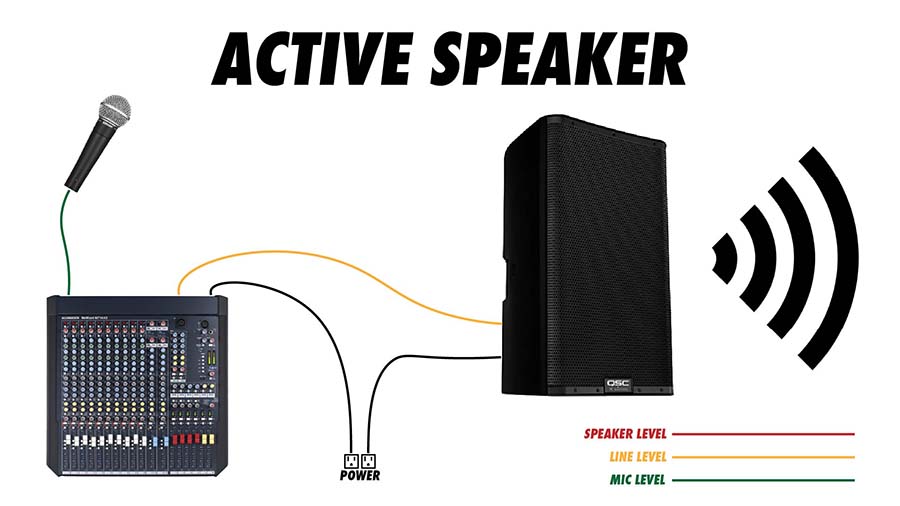If you’re wondering if you need an amplifier for your speakers – the short answer is “Yes, every speaker needs an amplifier”. Although, some speakers have an amplifier built-in.
In this post, I’ll help you determine if you have an active speaker with a built-in amplifier or a passive speaker that requires an external amplifier. I’ll also go through some of the benefits of each.
Active vs Passive Speakers
Like I said, there are two basic types of speakers when it comes to how they get their power: active and passive.
Active Speaker
An active speaker has an amplifier built-in and accepts a line level (or sometimes a mic level) signal.

Passive Speaker
A passive speaker accepts a speaker level signal from an external amplifier.

How To Tell The Difference
The easiest way to tell the difference is to determine if the speaker connects to power or not. If your speaker has a power cable that connects to the wall or if it’s battery powered, it’s an active speaker. If your speaker is passive, it will receive its power from the external amp.
The input connectors used on a speaker are also a good indicator. Active speakers will commonly have XLR inputs, ¼” inputs, ⅛” or 3.5mm inputs, and some even have the ability to receive signal via Bluetooth or WiFi. Passive speakers usually have a positive and negative terminal, ¼” inputs, or SpeakON inputs.

You’ll notice that a ¼” input can be found on an active or a passive speaker. The important thing to note here is that, although these inputs look the same, the type of cable you should use is not. When connecting an amplifier to a passive speaker, you’ll use a ¼” speaker cable and when connecting a mixer output to an active speaker, you’ll use an instrument cable or a TRS cable.
Benefits & Drawbacks
The main benefit of active speakers is simplicity and ease of setup. You just connect the speaker to power (or charge its battery) and then connect the output of your mixer or signal source to the speaker’s input. If the speaker has a mic level input, you can even connect a dynamic microphone directly.
When using a passive speaker, the external amp will connect to power and the line level signal from your mixer, receiver, or source will be sent to the input of the amplifier, amplified, and sent out of the amplifier at speaker level to the speaker.
Another benefit of active speakers is that the amplifier and digital signal processing built into the cabinet is sometimes specifically designed for that speaker. On the other hand, passive speaker manufacturers often produce amplifiers with presets for their speakers and sometimes publish recommended settings for using their speakers with third-party amps.
You also have more flexibility when using passive speakers to experiment with different amplifiers.
From an installation perspective, passive speakers have traditionally been more common because they are generally more lightweight than active speakers and don’t require power outlets at each speaker location like active speakers.
However, over recent years, active speakers have become more common. Amplifiers have become much lighter, allowing more power output with less weight. Also, PoE (or power over ethernet) has made it possible to send signal via a network protocol like Dante and power via a network switch to lightweight speakers distributed throughout a building.
I don’t want you to walk away from this video thinking one is totally better than the other. Active and passive speakers both have their place and it’s ultimately up to you to decide which one is best for your situation.
Choosing The Right Speakers
If you want some help choosing the right speakers, you can download the Speaker Specs Guide, which is a free guide to the most important specifications you should consider.
If you’ve already got passive speakers and want some help choosing the right amplifier, check out this post.
